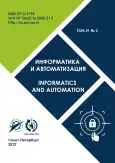Crop Identification Using Radar Images
- Authors: Dubrovin K.N1, Stepanov A.S2, Verkhoturov A.L3, Aseeva T.A2
-
Affiliations:
- Computing Center of the Far Eastern Branch of the Russian Academy of Sciences
- Far Eastern Agriculture Research Institute of the Russian Academy of Sciences (FEARI)
- Mining Institute of the Far Eastern Branch of the Russian Academy of Sciences (MI FEB RAS)
- Issue: Vol 21, No 2 (2022)
- Pages: 405-426
- Section: Artificial intelligence, knowledge and data engineering
- URL: https://journal-vniispk.ru/2713-3192/article/view/266346
- DOI: https://doi.org/10.15622/ia.21.2.7
- ID: 266346
Cite item
Full Text
Abstract
Keywords
About the authors
K. N Dubrovin
Computing Center of the Far Eastern Branch of the Russian Academy of Sciences
Email: nobforward@gmail.com
Kim Yu Chen St. 65
A. S Stepanov
Far Eastern Agriculture Research Institute of the Russian Academy of Sciences (FEARI)
Email: stepanfx@mail.ru
Klubnaya St. 13
A. L Verkhoturov
Mining Institute of the Far Eastern Branch of the Russian Academy of Sciences (MI FEB RAS)
Email: andrey@ccfebras.net
Turgeneva St. 51
T. A Aseeva
Far Eastern Agriculture Research Institute of the Russian Academy of Sciences (FEARI)
Email: aseeva59@mail.ru
Klubnaya St. 13
References
- Mapping croplands, cropping patterns, and crop types using MODIS time-series data / Y. Cheng [и др.] // International Journal of Applied Earth Observation and Geoinformation. 2018. vol. 69. pp. 133-147.
- Improved regional-scale Brazilian cropping systems’ mapping based on a semi-automatic object-based clustering approach / B. Bellon [и др.] // International Journal of Applied Earth Observation and Geoinformation. 2018. vol. 68. pp. 127-138.
- Griffiths P., Nendel C., Hostert P. Intra-annual reflectance composites from Sentinel-2 and Landsat for national-scale crop and land cover mapping // Remote Sensing of Environment. 2019. vol. 220. pp. 135-151.
- Accessing the temporal and spectral features in crop type mapping using multi-temporal Sentinel-2 imagery: A case study of Yi’an County, Heilongjiang province, China / H. Zhang [и др.] // Computers and Electronics in Agriculture. 2020. vol. 176. 105618.
- Early-season crop type mapping using 30-m reference time series / P. Hao [и др.] // Journal of Integrative Agriculture. 2020. vol. 19. iss. 7. pp. 1897-1911.
- Миклашевич Т.С., Барталев С.А., Плотников Д.Е. Интерполяционный алгоритм восстановления длинных временных рядов данных спутниковых наблюдений растительного покрова // Современные проблемы дистанционного зондирования Земли из космоса. 2019. Т. 16. №6. С. 143-154.
- Arias M., Campo-Bescós M.Á, Álvarez-Mozos J. Crop Classification Based on Temporal Signatures of Sentinel-1 Observations over Navarre Province, Spain // Remote Sensing. 2020. vol. 12. iss. 2. 278.
- Improved Early Crop Type Identification by Joint Use of High Temporal Resolution SAR And Optical Image Time Series / J. Inglada [и др.] // Remote Sensing. 2016. vol. 8. iss. 5. 362.
- Synergistic Use of Radar Sentinel-1 and Optical Sentinel-2 Imagery for Crop Mapping: A Case Study for Belgium / van Tricht K. [и др.] // Remote Sensing. 2018. vol. 10. iss. 10. 1642.
- Kim Y., van Zyl J.J. A Time-Series Approach to Estimate Soil Moisture Using Polarimetric Radar Data // IEEE Transactions on Geoscience and Remote Sensing. 2009. vol. 47. №8. pp. 2519-2527.
- C-band polarimetric indexes for maize monitoring based on a validated radiative transfer model / X. Blaes [и др.] // IEEE Transactions on Geoscience and Remote Sensing. 2006. vol. 44. iss. 4. pp. 791–800.
- Integration of optical and Synthetic Aperture Radar (SAR) imagery for delivering operational annual crop inventories / H. McNairn [и др.] // ISPRS Journal of Photogrammetry and Remote Sensing. 2009. vol. 64. iss. 5. pp. 434–449.
- Dual polarimetric radar vegetation index for crop growth monitoring using Sentinel-1 SAR data / D. Mandal [и др.] // Remote Sensing of Environment. 2020. vol. 247. 111954.
- Freeman A., Durden S.L. A Three-Component Scattering Model for Polarimetric SAR Data // IEEE Transactions on Geoscience and Remote Sensing. 1998. vol. 36. iss. 3. pp. 963-973.
- Four Component Scattering Model for Polarimetric SAR Image Decomposition / Yamaguchi Y. [и др.] // IEEE Transactions on Geoscience and Remote Sensing. 2005. vol. 43. iss. 8. pp. 1699-1706.
- Arii M., van Zyl J.J., Kim Y. Adaptive Model-Based Decom-position for Polarimetric SAR Covariance Matrices // IEEE Transactions on Geoscience and Remote Sensing. 2011. vol. 49. iss. 3. pp. 1104-1113.
- Костенков Н.М., Ознобихин В.И. Почвы и почвенные ресурсы юга Дальнего Востока, и их оценка // Почвоведение. 2006. №5. С. 517–526.
- Новороцкий П.В. Климатические изменения в бассейне Амура за последние 115 лет // Метеорология и гидрология. 2007. №2. С. 43−53.
- База данных показателей муниципальных образований. URL: www.gks.ru/dbscripts/munst/ (дата обращения: 21.08.2021).
- Sentinel-1 Mission Status / P. Potin [и др.] // 11th European Conference on Synthetic Aperture Radar. Proceedings EUSAR. 2016. pp. 59–64.
- Intensity and phase statistics of multilook polarimetric interferometric SAR imagery / J.S. Lee [и др.] // IEEE Transactions on Geoscience and Remote Sensing. 1994. vol 32. iss. 5. pp. 1017-1028.
- Lee J.S., Pottier E. Polarimetric SAR Radar Imaging: From Basic to Applications // Boca Raton: CRC Press. 2009. 438 p.
- Predicting the Normalized Difference Vegetation Index (NDVI) by training a crop growth model with historical data / A. Berger [и др.] // Computers and Electronics in Agriculture. 2018. vol. 161. pp. 305-311.
- An improved logistic method for detecting spring vegetation phenology in grasslands from MODIS EVI time-series data. / R. Cao [и др.] // Agric. For. Meteorol. 2015. vol. 200. pp. 9–20.
- Predicting Soybean Yield at the Regional Scale Using Remote Sensing and Climatic Data / A. Stepanov [и др.] // Remote Sensing. 2020. vol. 12. iss. 12. 1936.
- Evaluating the impacts of models, data density and irregularity on reconstructing and forecasting dense Landsat time series. / J. Zhang [и др.] // Science of Remote Sensing. 2021. №4. 100023.
- Mapping crops within the growing season across the United States / V.S. Konduri [и др.] // Remote Sensing of Environment. 2020. vol. 251. 112048.
Supplementary files









